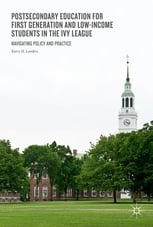You have /5 articles left.
Sign up for a free account or log in.
Many educators talk about the need for elite colleges to recruit and graduate more students from disadvantaged backgrounds. Kerry H. Landers, assistant dean of graduate student affairs at Dartmouth College, followed a group of such students at Dartmouth to learn more about their experiences. The result is Postsecondary Education for First-Generation and Low-Income Students in the Ivy League (Springer). Via email, Landers responded to questions about the book.
 Q: What were the key strategies of Dartmouth (and of the students you studied) that resulted in their enrolling?
Q: What were the key strategies of Dartmouth (and of the students you studied) that resulted in their enrolling?
A: Dartmouth reaches out to students with high SAT scores and offers a strong financial aid program along with its Ivy League reputation. I think the most important factor in whether students enroll at Dartmouth is a relationship with someone who encouraged them to go to college -- or to Dartmouth. It may have been a parent, a teacher or guidance counselor who encouraged them to apply, or someone in their peer group. For example, Kevin got into a large state school and Dartmouth; it was his college counselor who told him he should choose Dartmouth. Chris only considered community college until one of his teachers encouraged him to look at four-year colleges.
Q: What admissions policies remain as roadblocks to the admission of students such as those you studied?
A: There were three hurdles that seemed relevant for low-income, first-generation students. While legacy and early-decision admission policies don’t directly prevent low-income students from getting accepted, they do give greater advantage to wealthier students. By definition, first-generation students miss out on the benefit of having legacy status. In addition, most low-income first-generation students can’t apply early decision because they must wait to compare financial aid packages from all their acceptances. Even then, making sense of the financial aid package is nearly impossible unless colleges agree to use a standardized form that breaks down costs and benefits in a uniform way.
Recently, The New York Times reported that Senators Al Franken and Charles Grassley have introduced three pieces of legislation to make comparable costs of college clearer to applicants. Institutions also need to remove obfuscating jargon from their financial aid letters. Once enrolled, students should have a clear way to track their debt. Currently, it is hard for low-income students to know what they are committing to, especially if they don’t have a parent who has been through the process to guide them.
Q: You write about the adjustments from growing up in a low-income home to enrolling at an elite college. What can colleges do better on helping students facing the adjustment?
A: Since the default assumption in an Ivy institution is that all students come from at least a middle-class background, elite colleges can help ease the transition with programs that enable students to meet informally with faculty and student peer mentors early on, and to be introduced to resources on campus. Although many schools offer these programs, they may need to increase their budgets to boost enrollment. Programs like these should be available to all who apply.
Institutions may also need to consider how the structure and content of first-year orientation translates for first-generation and low-income students. For example, Dartmouth offers a week-long orientation involving many outdoor activities. Most alumni have fond memories of it. But in interviews with first-generation students, it became clear that some students can’t afford to take a week off from paid employment to attend. Others worried that they did not have adequate hiking or camping equipment, or found the whole idea of bonding in nature distasteful.
Students who did not attend the orientation events felt especially isolated when it seemed everyone else returned to campus knowing a small group of people. Institutions need to be aware of these dynamics and come up with alternatives.
Q: Many traditions of elite colleges, educational or otherwise, cost money. Students may go on spring break or study abroad, take unpaid internships, etc. How can colleges best make sure that admission really means full admission to the college?
A: Colleges may not be able to justify covering all those types of costs. Going to Florida for spring break is a vacation! However, if a varsity sports team is training in Florida for spring break, it seems appropriate for the school to help cover the costs. Similarly, it is easy to justify supplementary funds for a study abroad program or unpaid internship that is part of the educational mission of the college.
Most concerning is the number of students who said they could not afford books (textbooks often cost more than $100). How can we expect students to do well in their classes if they can’t even afford the assigned materials? Clearly, it is essential that schools provide funding so low-income students can buy books (or art supplies, calculators, etc.) for their academic classes, regardless of their major.
Q: What are the main obstacles to college success for these students? What can colleges do to increase the odds of success?
A: Most of these students coming to our campuses don’t instantly feel they belong there. Elite Institutions should question if they have programs and policies in place that communicate that these students are valued and do belong. Often, we assume institutions are helping these students. However, we need to recognize many of these students are “flying their own helicopters” and demonstrate an amazing amount of perseverance and independence that contribute to our student body. Institutions also need to realize even with generous financial aid, low-income students struggle with the cost of going to elite schools.
It is important for elite schools to assess the additional fees that we take for granted are affordable for all students and make adjustments. First-generation and low-income students admitted to elite institutions tend to be self-sufficient, successful high school students; they may be reluctant to ask for help or they may interpret it as a sign of failure. It is important that elite colleges find ways to ensure these students have access to administrators and connections with faculty early on.
They also need peer programs that let them know they are not the only low-income, first-generation student on campus. Having a supportive peer group in college helps them see others like themselves, build community and feel they belong there, too. It is critical to their success to feel they belong at our institutions.








